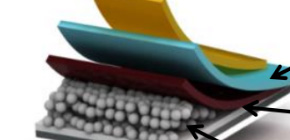
Time for exploring materials for next-generation solar cells significantly shortened
Practical use of next-generation solar cells accelerated by statistics and high-speed evaluation technique
Associate Professor SAEKI Akinori and Graduate Student ISHIDA Naoki at the Graduate School of Engineering, Osaka University, and Associate Professor WAKAMIYA Atsushi at the Institute of Chemical Research, Kyoto University, using statistics and LASSO (least absolute shrinkage and selection operator) analysis, developed a new technique for quickly evaluating the performance of hole transfer materials for transferring generated holes to electrodes in perovskite solar cells, which are anticipated as next-generation solar cells. This technique has made it possible to perform stable evaluation in a time equivalent to or shorter than one-tenth of the time compared to conventional device evaluation methods.
A perovskite solar cell is made up of a perovskite layer, through which light is absorbed, generating positive holes and negative electrons, and a hole transport layer (HTL), which separates holes and electrons into the anode and cathode, respectively. As of 2016, a conversion efficiency rate stands at 22 percent, which is equivalent to that of inorganic solar cells. It’s possible to produce perovskite solar cells at lower prices and in compact forms because they can be fabricated using a low temperature process and by an inkjet printing technique, so they are expected to be commercialized as next-generation solar cells. In order to increase the photoelectric conversion rate of solar cells, the development of a high-performance charge transport layer is necessary. However, extended time and repeated experiments were necessary for the production and performance evaluation of hole transport layers consisting of organic polymer materials and low molecular materials because many factors were involved in the performance of the device.
This group established a method for directly evaluating the hole transfer yield from the perovskite layer to the hole transport layer in perovskite solar cells by using a measurement device combining microwaves used for smartphone communication and microwave ovens. Furthermore, this group succeeded in extracting variables for determining performance by using statistics and LASSO analysis. This group clarified that the product obtained by multiplying the initial hole transfer yield and the transfer speed was most closely correlated to short-circuit current density, which made it very easy to develop and evaluate new hole transport materials.
In addition, it was also found that not only the type of polymers, but also whether additives were added or not and the time of exposure to air affected the hole transfer yield as well. Perovskite solar cells deteriorate in quality due to exposure to moisture in the air but increase their performance due to light exposure and oxygen with time, which was one of the mysteries of perovskite solar cell behavior. This group quantified the phenomenon that hole transfer yield increases steadily over time with exposure to air, which will offer a clue for solving many unsolved mysteries.
Perovskite solar cells with the highest power conversion efficiency contain lead (Pb), which is toxic to humans and the environment, so the development of non-lead perovskite solar cells is sought after. However, power conversion efficiencies of non-lead perovskite solar cells are very low and there are also many challenges regarding their durability and stability. In addition to the benchmark established in this study, using materials informatics will make it possible to efficiently explore new materials for charge transport layers. Many mysteries of Perovskite solar cells, such as their deterioration mechanism and hysteresis, still remain. It is expected that based on this group’s achievement, providing experimental solutions and using them for performance evaluation of multiple energy conversion materials using sunlight, including next-generation solar cells, will accelerate improvement in device performance and research to clarify basic properties.
Abstract
Organic–inorganic hybrid perovskites provide not only an exceptionally rich area of research but also remarkable power conversion efficiency relevant to commercial use. However, developing efficient organic hole transport layers remains challenging, due partly to the subtle electronic behavior of perovskite and complications introduced by the use of reactive dopants. Here we show, through time-resolved microwave conductivity, the quantification of a hole transfer process from methylammonium lead triiodide perovskite to eight kinds of conjugated polymers with and without a Li dopant. The time evolution of hole transfer yield is characterized by kinetic parameters, which are further examined in conjunction with solar cell performance, energetics, and temporal profiles triggered by exposure to air at the minute scale. Using statistics and LASSO (least absolute shrinkage and selection operator) analysis, we identify an accurate descriptor that correlates with device output. This work explores the design of organic hole transport materials, and the presented evaluation technique may be employed as a facile screening method.

Figure 1. Structure of perovskite solar cell.

Figure 2. Direct evaluation of hole transfer yield using microwave technique. (a) Schematic of microwave measurement. The amplitude of microwave absorption associated with the electric conductivity is decreased when laser pulse is exposed. (b) Microwave signals of perovskite without HTL (black) and with HTL (blue and red). The polymers of HTL are different between A and B. The length of arrow represents the hole transfer yield, where polymer A is higher than polymer B.

Figure 3. Correlation between device parameter (vertical) and microwave evaluation (horizontal) as analyzed by statistics. Each dot correspond to one HTL material.
To learn more about this research, please view the full research report entitled “ Quantifying Hole Transfer Yield from Perovskite to Polymer Layer: Statistical Correlation of Solar Cell Outputs with Kinetic and Energetic Properties ” at this page of the ASC Photonics website.
Related link

